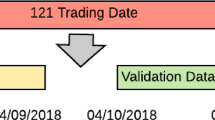Abstract
Investment behavior is influenced by various behavioral biases. Two among them are disposition effect and anchoring. Using market level data, we investigate the presence of disposition effect in Indian stock markets. Initially, it was found that high (low) trading volumes are not associated with winner (loser) stocks. Further based on the evidence provided by studies done on market level data, we consider abnormal trading volumes as the proxy for disposition effect. Investors’ tendency to update their reference points and the prominence of historical prices (anchors) as reference points allowed a study to test the association between abnormal trading volumes and historical prices. Except for familiar and highly liquid stocks (Nifty50 index stocks) this study found that abnormal trading volumes are associated with a significantly more percentage of winning days than that of losing days. This study is useful for investors and fund managers while taking trading decisions and also when forming the portfolios.



Similar content being viewed by others
References
Ali, R., & Afzal, M. (2012). Impact of global financial crisis on stock markets: Evidence from Pakistan and India. Journal of Business Management and Economics., 3(7), 275–282.
Baker, M., Pan, X., & Wurgler, J. (2012). The effect of reference point prices on mergers and acquisitions. Journal of Financial Economics., 106, 49–71. https://doi.org/10.1016/j.jfineco.2012.04.010.
Barberis, N., & Xiong, W. (2009). What drives the disposition effect? An analysis of a long- standing preference-based explanation. Journal of Finance., 64, 751–784. https://doi.org/10.2139/ssrn.890271.
Baucells, M., Weber, M., & Welfens, F. (2011). Reference-point formation and updating. Management Science, 57(3), 506–519. https://doi.org/10.1287/mnsc.1100.1286.
Bremer, M., & Kato, K. (1996). Trading volume for winners and losers on the Tokyo Stock Exchange. Journal of Financial and Quantitative Analysis, 31(1), 127–142.
Bry, G., & Boschan, C. (1971). Front matter to "Cyclical analysis of time series: Selected procedures and computer programs". In Cyclical analysis of time series: Selected procedures and computer programs (pp. 13–2). NBEr.
Campbell, J. Y., Ramadorai, T., & Ranish, B. (2013). Getting better: Learning to invest in an emerging stock market. Tech. rep. Available at SSRN.
Dhar, R., & Zhu, N. (2006). Up close and personal: investor sophistication and the disposition effect. Management Science, 52(5), 726–740. https://doi.org/10.1287/mnsc.1040.0473.
Frazzini, A. (2006). The disposition effect and underreaction to news. American Finance Association, 61(4), 2017–2046.
Gonzalez, L., Powell, J. G., Shi, J., & Wilson, A. (2005). Two centuries of bull and bear market cycles. International Review of Economics & Finance, 14(4), 469–486.
Huddart, S. J., Lang, M. H., & Yetman, M. (2005). Psychological factors, stock price paths, and trading volume. SSRN Electronic Journal. https://doi.org/10.2139/ssrn.687065.
Kaustia, M. (2010). Disposition effect. Behavioral Finance: Investors, Corporations, and Markets, 6(171), 791–812.
Lakonishok, J., & Smidt, S. (1986). Volume for winners and losers: taxation and other motives for stock trading. The Journal of Finance, 41(4), 951–974.
Ma, Q., Wang, H., & Zhang, W. (2017). Trading against anchoring. Review of Behavioral Finance, 9(3), 242–261. https://doi.org/10.1108/RBF-04-2016-0014.
Odean, T. (1998). Are investors reluctant to realize their losses? The Journal of Finance, 53(5), 1775–1798.
Ranganathan, K., & Singh, P. (2014). NSE WORKING PAPER reference price bias and regulations in indian mergers and acquisitions, (March).
Shefrin, H., & Statman, M. (1985). The disposition to sell winners too early and ride losers too long: Theory and evidence. The Journal of Finance, 40(3), 777–790.
Shu, P. G., Yeh, Y. H., Chiu, S. B., & Chen, H. C. (2005). Are Taiwanese individual investors reluctant to realize their losses? Pacific Basin Finance Journal, 13(2), 201–223. https://doi.org/10.1016/j.pacfin.2004.08.001.
Tversky, A., & Kahneman, D. (1974). Judgment under uncertainty: Heuristics and biases. Science, 185(4157), 1124–1131.
Weber, M., & Camerer, C. F. (1998). The disposition effect in securities trading: An experimental analysis. Journal of Economic Behavior & Organization, 33(2), 167–184. https://doi.org/10.1016/S0167-2681(97)00089-9.
Author information
Authors and Affiliations
Corresponding author
Additional information
Publisher's Note
Springer Nature remains neutral with regard to jurisdictional claims in published maps and institutional affiliations.
Rights and permissions
About this article
Cite this article
Bharandev, S., Rao, S.N. Does The Association Between Abnormal Trading Volumes And Historical Prices Explain Disposition Effect?. Asia-Pac Financ Markets 28, 141–151 (2021). https://doi.org/10.1007/s10690-020-09321-5
Published:
Issue Date:
DOI: https://doi.org/10.1007/s10690-020-09321-5




